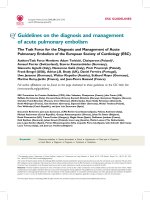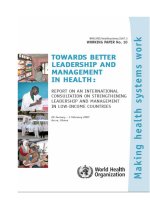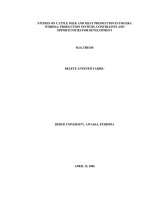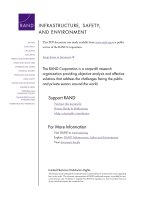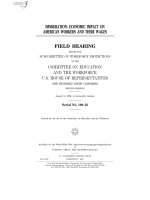Negative skin friction on single piles and pile groups
Bạn đang xem bản rút gọn của tài liệu. Xem và tải ngay bản đầy đủ của tài liệu tại đây (10.12 MB, 372 trang )
NEGATIVE SKIN FRICTION ON
SINGLE PILES AND PILE GROUPS
SHEN RUIFU
NATIONAL UNIVERSITY OF SINGAPORE
2008
NEGATIVE SKIN FRICTION ON
SINGLE PILES AND PILE GROUPS
SHEN RUIFU
(BEng, Tsinghua University)
(MEng, National University of Singapore)
A THESIS SUBMITTED
FOR THE DEGREE OF DOCTOR OF PHILOSOPHY
DEPARTMENT OF CIVIL ENGINEERING
NATIONAL UNIVERSITY OF SINGAPORE
2008
i
ACKNOWLEDGEMENTS
I would like to express my deep and sincere gratitude to my supervisors, Professor
Leung Chun Fai and Professor Chow Yean Khow for their detailed and persistent
guidance and critical discussions during numerous meetings over the past six years
which gradually shape the outcome of the present research work in its present form. I
would also like to thank A/Prof. Phoon Kok Kwang and Prof. Tan Thiam Soon for
their valuable and constructive suggestions during the course of this research project.
Working on a part-time basis for my PhD thesis as a Professional Officer in the
NUS Centre for Soft Ground Engineering (CSGE) enables me to have opportunities to
interact closely with the brilliant geotechnical professors in CSGE whom I have the
privilege to refer to as my “colleagues”. A/Prof. Tan Siew Ann is always enthusiastic
in demonstrating to me the wonderful Geotechnical software suite Plaxis inside out
and encouraging me to adopt Plaxis 3D Foundation for the FEM analysis of the
perplexing pile-soil-pile interaction of piles subjected to NSF. From A/Prof. Lee Fook
Hou, I learned Critical State Soil Mechanics and fascinating soil constitutive modelling
which have been intriguing me long ago during my undergraduate years when I first
came in contact with soil mechanics and geotechnical engineering. Dr Chew Soon Hoe
is always very encouraging and provides valuable advices during the course of my
juggling between research work and laboratory duties. I was awed from time to time
by the vast knowledge and insightful views from Prof. Yong Kwet Yew. The more I
learn soil mechanics and geotechnical engineering, the more my realization of my
ignorance of the subject. “Our knowledge can only be finite, while our ignorance must
necessarily be infinite”, to quote the wisdom word of Karl Popper (1902-1994).
ii
As a research and laboratory staff, I mingle daily with the laboratory officers in the
NUS Centrifuge and Geotechnical Laboratories: Choy Moon Nien, Foo Hee Ann,
Jamilah Mohd, Loo Leong Huat, Shaja Khan Abdul Kassim, Tan Lye Heng, and Wong
Chew Yuen. They always warmly and kindly extend their helping hands whenever
needed and I enjoy brotherly and sisterly relationship with them which make me feel
like going to the office every morning I wake up. Our conducive working ambience
and productive teamwork manifest loudly with the 3 consecutive accolades of gold
medals awarded to our PILLAR team formed by the laboratory staff participating in
the Work Improvement Team (WIT) competition in the Singapore National Quality
Circle Convention (NQCC).
The favourable policies of the National University of Singapore pertaining to NUS
staff pursuing higher degrees on part-time basis are gratefully acknowledged. Thanks
are due to the Department of Civil Engineering of NUS for the generous helps and
various supports.
Finally, I would like to dedicate this thesis to my dearest wife, Lu Yu Xia, and my
loveliest daughter, Shen Yuan Yuan, who are always caring and understanding which
give me a peace of mind even if I on some occasions need to run the centrifuge tests
into the wee hours.
January 2008
Shen Rui Fu
iii
TABLE OF CONTENTS
Acknowledgements i
Table of Contents iii
Summary viii
Nomenclature x
List of Tables xiii
List of Figures xiv
CHAPTER 1 INTRODUCTION
1.1 Background 1
1.2 Objective and Scope of Study 5
1.2 Layout of Thesis 6
CHAPTER 2 LITERATURE REVIEW
2.1 Introduction 9
2.2 Current Understanding and Uncertainties of NSF 11
2.2.1 When We Need to Consider NSF 11
2.2.2 Relative Movement Required for Mobilization of NSF 14
2.2.3 Magnitude of NSF 19
2.2.4 Location of Neutral Point (NP) 23
2.2.5 NSF on Cast-in-situ bored piles 27
2.3 Design Philosophy 29
iv
2.4 Negative Skin Friction on Pile Groups 36
2.4.1 Field Tests on Pile Group Subject to NSF 36
2.4.2 Laboratory Small-scale Tests on Pile Groups Subject to 38
2.4.3 Centrifuge Model Tests on Pile Groups Subject to NSF 39
2.5 Numerical Study of NSF on Piles 42
2.6 Concluding Remarks 46
CHAPTER 3 EXPERIMENTAL SETUP AND PROCEDURE
3.1 Introduction 58
3.2 Model Setup 60
3.2.1 Soil Container 60
3.2.2 Supporting Frame, Slider Plate and Sand Hoppers 61
3.2.3 Hydraulic Actuators and Servo-valve Control System 61
3.3 Instrumentation and Transducers 63
3.3.1 Instrumented Model Piles 63
3.3.2 Transducers used in Model Setup 67
3.3.3 In-flight Piezocone 68
3.4 Model Ground Preparation 70
3.5 Completed Model Package 72
3.6 Experimental Procedure 74
3.6.1 Soil Self-weight Consolidation at 80g 74
3.6.2 In-flight Pile Installation 75
3.6.3 Soil Re-consolidation after Pile Installation 75
3.6.4 Simulation of Underground Water Drawdown 75
v
3.6.5 Application of Dead Load 77
3.6.6 Surcharge Loading 77
3.6.7 Simulation of Transient Live Loads 78
3.6.8 Post-flight Tests 78
CHAPTER 4 NSF ON SINGLE PILES
4.1 Introduction 91
4.2 Model Ground Characterization 94
4.2.1 Undrained Shear Strength Profile 94
4.2.2 Physical Properties of Clay 97
4.3 Test results on End-bearing Single Pile 98
4.3.1 Stage 1: Soil Self-weight Consolidation 98
4.3.2 Stage 2: In-flight Pile Installation 99
4.3.3 Stage 3: NSF due to Soil Re-consolidation 103
4.3.4 Stage 4: NSF due to Water Drawdown 107
4.3.5 Stage 5: Application of Dead Load on Pile 111
4.3.6 Stage 6: NSF due to surcharge 112
4.3.7 Stage 7: Effect of Live Loads on NSF 116
4.3.8 Brief Summary of Test ES 122
4.4 Test Results on Floating Pile and Socketed Pile 124
4.4.1 Stage 1: Soil Self-weight Consolidation 126
4.4.2 Stage 2: In-flight Pile Installation 126
4.4.3 Stage 3: NSF due to Soil Re-consolidation 127
4.4.4 Stage 4: NSF due to Water Drawdown 130
vi
4.4.5 Stage 5: Application of Dead Load on Pile 131
4.4.6 Stage 6: NSF due to Surcharge 132
4.4.7 Stage 7: Effect of Live Loads on NSF 134
4.5 Concluding Remarks 136
CHAPTER 5 NSF ON PILE GROUPS
5.1 Introduction 171
5.2 Boundary Effect of Pile Groups with NSF 173
5.3 Behavior of End-bearing pile groups with NSF 179
5.4 Behavior of Socketed Pile Groups 186
5.5 Comparison of Measured Dragloads on Pile Groups Against
Empirical and analytical Estimations
189
5.5.1 Empirical Methods 190
5.5.2 Analytical Methods 196
5.5 Concluding Remarks 204
CHAPTER 6 NUMERICAL ANALYSIS OF NSF USING FEM
6.1 Introduction 222
6.2 NSF on End-bearing Single Piles 224
6.2.1 FEM Mesh and Soil Properties 224
6.2.2 Interface Elements for Pile-soil Interaction 226
6.2.3 Back-analysis Procedure and Results 233
6.2.4 MC model versus MCC model 237
6.2.5 Drained versus Consolidation Analysis 239
vii
6.2.6 Degree of Mobilization for End-bearing Piles 240
6.2.7 Effect of Transient Live Load on NSF 245
6.3 NSF on Socketed Single Piles 247
6.3.1 Back-analysis Procedure and Results 247
6.3.2 Settlement of Socketed Piles with NSF 249
6.3.2.1 Current understanding 249
6.3.2.2 Back-analysis of Socketed Pile Settlement 252
6.3.2.3 Generalized Settlement Behavior of Socketed Piles 254
6.4 Numerical Simulation of NSF on End-bearing Pile Groups 258
6.4.1 Numerical 3D Simulation Methodology 258
6.4.2 Back-analysis of End-bearing Pile Groups 259
6.4.3 Mechanism of Pile Group Effect with NSF 263
6.4.4 Boundary Effect on Pile Group with NSF 266
6.4.5 Moderation Effect of pile Cap on Pile Group 268
6.4.6 Generalization of NSF Group Reduction Factor 270
6.5 Numerical Simulation of NSF on Socketed Pile Groups 273
6.6 Concluding Remarks 276
CHAPTER 7 CONCLUSIONS AND RECOMMENDATIONS
7.1 Conclusions 318
7.2 Recommendations for Future Studies 325
APPENDIX A1~A11
REFERENCE R1~R12
viii
SUMMARY
It has long been recognized that negative skin friction (NSF) which is
detrimental to piled foundations can be induced to piles installed through
consolidating soils. In the present study, centrifuge model tests have been conducted
to investigate the combined effects of NSF, dead load as well as transient live load
on an “end-bearing” pile, a “floating” pile and a “socketed” pile, denoting the three
most common pile load bearing situations in the field. An elaborate test control
scheme has been developed to seamlessly incorporate 7 sequential test stages into
each model test to induce NSF on the instrumented pile through 3 typical means,
namely re-consolidation of remolded clay after pile installation, ground water
drawdown as well as surcharge loading. As the entire test process can be conducted
without stopping the centrifuge, the pile behavior can be scrutinized in a
comprehensive and rational manner. Besides critically evaluating the understanding
of NSF established in previous studies, new findings arising from the present model
tests provide new insights on the mechanism of NSF on single piles.
The centrifuge model study was subsequently extended to pile groups comprising
3, 5, 9 and 16 piles connected by a rigid pile cap. The model pile shafts were
instrumented with highly sensitive semi-conductor strain gauges in full-bridge
configuration. As a result, the subtle difference in the induced dragload among piles
in a group as well as the group effects of NSF can be qualitatively explored in a
consistent and rigorous manner. These test data are invaluable in view of the dearth
of such data in the literature and are readily utilized to evaluate the appropriateness
ix
of some commonly used empirical and analytical formulas for the calculation of
dragload for pile groups.
Numerical analyses on single piles and pile groups subjected to NSF using both
axisymmetric and 3D Finite Element Method (FEM) have also been conducted. It is
established that the incorporation of interface elements at the pile-soil interface with
appropriate properties pertaining to constitutive models adopted for soils around the
pile shaft is crucial in order to capture the NSF induced on piles correctly. The partial
mobilization of NSF around the neutral point (NP) can be clearly visualized by the
observation of yielding zones along the pile-soil interface elements. The numerical
exploration of the reduced effective stress regime within pile groups supplements the
physical model tests in revealing the fundamental mechanism of NSF group effects.
The axisymmetric and 3D numerical tools, carefully calibrated using centrifuge data,
were subsequently applied to the further in-depth investigation of some important
issues revealed by the present centrifuge model tests. These include the degree of
mobilization of NSF, the effect of transient live loads on the lock-in dragload at the
neutral point, the appropriate geotechnical consideration for socketed piles based on
allowable settlement; the adverse implication of the unbalanced stresses inside and
outside a pile group due to NSF; the moderation effect of a rigid pile cap as well as
the variation of NSF group reduction factors with the pile-soil conditions.
Keywords: Negative skin friction; Dragload; Downdrag settlement; Single Pile; Pile
group; Centrifuge model test; Finite element method
x
NOMENCLATURE
A Section area enclosed within a pile group
A
b
Cross-section area of a pile
A
s
Area of pile shaft in contact with competent soil
B Width of a pile group
C Circumference of a pile
C
u
Undrained shear strength of clay
d Pile diameter
D’ Depth of top fill
D’’ Depth of compressible soil
e Pile socketed length
E
b
Young’s modulus of underlying competent soil
E’ Effective Young’s modulus of clay
E
u
Undrained Young’s modulus of clay
E
p
Young’s modulus of pile
EA Pile axial rigidity
f Pile-soil flexibility factor
f
n
Unit negative friction on pile shaft
f
s1
-
Average ultimate NSF above NP
f
s1
+
Average ultimate positive skin friction below NP
f
s2
Shaft resistance mobilized in competent soil
g gravitational acceleration (9.8 m/s
2
)
G Shear modulus of soil
G
b
Shear modulus of underlying competent soil
H
c
Thickness of clay stratum
I
p
Plasticity index of clay
k Coefficient of horizontal earth pressure
K Pile-soil stiffness ratio
L Pile length
xi
L
n
Elevation of neutral point
n’ Number of piles per unit surface area
N Number of piles in group
N
q
Pile base bearing resistance factor
N
k
Empirical penetration cone factor
R
A
Pile section ratio
P
0
Load on pile head from superstructure
p’ Effective mean normal stress
P
n
Dragload on a pile
q Deviator stress
q
0
Surcharge loading
q
c
Penetration cone tip resistance
Q
n
,
mob
Actual mobilized maximum dragload at NP
Q
n
,
β
Calculated maximum dragload at NP based on β method
Q
u
Ultimate pile geotechnical capacity
r
0
Radius of a pile
r
m
Radius from center of pile where shear stress is negligible
R Radius of region where soil becomes plastic
W
L
Liquid limit of clay
W
p
Plastic limit of clay
Z
nmax
Calculated maximum possible elevation of NP
w
z
Required relative movement of pile to soil for elimination of NSF
α
Total stress parameter for NSF
β
Effective stress parameter for NSF
φ’
Soil effective friction angle
φ
n
Partial factor for downdrag load
φ’
int
Effective friction angle of interface element
σ
v
’
Effective vertical stress in soil
σ
0z
’
Initial in-situ vertical effective stress at depth z
σ
h
’
Normal effective stress on the interface element
xii
γ’
Effective unit weight of soil
γ
w
Unit weight of water
δ
Elastic compression of the pile under downdrag force
ν
Poisson ratio of soil
ξ
Ratio of shear modulus at half and base of soil depth
τ
Shear stress in soil
τ
0
Shear stress at pile-soil interface
ε
a
Vertical strains
ε
r
Horizontal strains
ε
s
p
Plastic deviator strain
ε
v
p
Plastic volumetric strain
ε
v
e
Elastic volumetric strain
ε
v
p
Plastic volumetric strain
M Slope of critical state line in p’-q space
λ
Slope of isotropic compression line in p’-v space
κ
Slope of swelling line in p’-v space
η
Degree of mobilization of NSF
Abbreviations
FEM Finite Element Method
FOS Factor of Safety
GRF Group Reduction Factor of NSF
LL Live Load
MC Mohr Coulomb model
MCC Modified Cam Clay model
NSF Negative Skin Friction
NP Neutral Point
PPT Pore Pressure Transducer
UDL Uniformly Distributed Load
xiii
LIST OF TABLES
Table 3.1 Centrifuge scaling relationship (adapted from Leung et al., 1991)
59
Table 3.2 Some properties of Malaysian kaolin clay
71
Table 4.1 Summary of test configurations for single piles
92
Table 4.2 Comparison of cumulative dragloads and downdrag settlements
140
Table 5.1 Measured dragloads and group reduction factors from end-bearing
pile group tests
184
Table 5.2 Measured dragload and NSF group reduction factor from socketed
pile group tests
189
Table 5.3 Calculation of empirical dragload for end-bearing 16-pile group in
Test EG-16
194
Table 5.4 Comparison of calculated and measured dragload for end-bearing
pile groups
195
Table 5.5 Comparison of calculated and measured dragload for SOCKETED
pile groups
196
Table 5.6 Calculation of dragload on piles in end-bearing pile groups by
Shibata’s analytical solution
202
Table 5.7 Calculation of dragload on piles in socketed pile groups by
Shibata’s analytical solution
203
Table 6.1 Parameters Used for FEM Back-analysis of NSF on Piles
225
Table 6.2 FEM Back-analysis Steps for End-bearing Pile in Test-ES
235
Table 6.3 FEM Back-analysis Steps for socketed Pile in Test-SS
248
Table 6.4 Breakdown of geotechnical capacity in centrifuge model Test-SS
256
Table 6.5 Geotechnical Capacity of Socketed Pile with Increased
Embedment Length over That in Centrifuge Model Test-SS
257
Table 6.6 Comparison of Measured and Calculated Dragloads for All the
End-bearing Pile Group Tests
262
Table 6.7 Comparison of Measured and Calculated Dragloads for All the
Socketed Pile Group Tests
275
Page
xiv
LIST OF FIGURES
Figure 2.1 Illustration of negative skin friction on a pile 49
Figure 2.2 Axial load distribution after pile driving (After Fellenius, 1972) 50
Figure 2.3 Summary of negative friction data in dimensionless form (After
Walker and Darval, 1970)
51
Figure 2.4 Fellenius’s proposal for construction of neutral plane (After
Fellenius, 1988)
52
Figure 2.5 Skin friction distribution along a pile (After Poulos, 1997) 52
Figure 2.6 Theoretical load distribution in pre-stressed pile under applied load
(After Bozozuk, 1981)
53
Figure 2.7 Load distribution in test pile (After Bozozuk, 1981) 53
Figure 2.8 Effects of applied load on lock-in NSF along pile shaft (After Leung
et al., 2004)
54
Figure 2.9 Axial force versus depth for “friction pile group” (After Little, 1994) 55
Figure 2.10 Axial force versus depth for “end-bearing pile group” (After Little,
1994)
56
Figure 2.11 Increase of downdrag force with time (After Shibata et al., 1982) 57
Figure 3.1 Schematic model setup (unit in mm) 79
Figure 3.2 A completed model package mounted on Centrifuge platform ready
to spin up
80
Figure 3.3 Top view of supporting frame, sand hoppers and slider plate 81
Figure 3.4 Hydraulic servo-valves onboard the Centrifuge 81
Figure 3.5 An elaborated hydraulic servo-valve control system adopted for the
present study
82
Figure 3.6 Electrical circuits in control room 83
Figure 3.7 Test of aluminum tube used for model piles 83
Page
xv
Figure 3.8 Measured stress-strain relationship of aluminum tube used for the
fabrication of model piles
84
Figure 3.9 Schematic configuration for each level of strain gauge station along
the pile shaft
84
Figure 3.10 Schematic of a instrumented model pile (unit in mm) 85
Figure 3.11 Completed instrumented model piles and dummy piles 86
Figure 3.12 Pile head assembly with coupling connector 86
Figure 3.13 In-flight miniature piezocone 87
Figure 3.14 Pressures acting on a piezometer cone during a penetration test 87
Figure 3.15 Initial attempt of using solenoid valve for water drawdown 88
Figure 3.16 Solenoid valve oriented such that the plunger (a) aligns with the high
g direction; or (b) in perpendicular to the high g direction
88
Figure 3.17 An improvised scheme for water drawdown during a model test 89
Figure 3.18 Post-flight vane shear test 90
Figure 4.1 Model test configurations for single piles 141
Figure 4.2 (a) Undrained shear strength and (b) strength ratio of model clay
with depth
142
Figure 4.3 Variation of (a) water content, (b) void ratio, and (c) bulk unit weight
of the clay with depth
142
Figure 4.4 Development of pore pressures and soil settlement during spinning
up to 80g and subsequent self-weight consolidation
143
Figure 4.5 Variation of degree of consolidation with time 144
Figure 4.6 Variation of force at selected levels along pile shaft during pile
installation
145
Figure 4.7 Variation of excess pore pressure and ground heave as pile
penetrated through model ground
145
Figure 4.8 Maximum excess pore pressure along clay depth due to pile
installation
146
xvi
Figure 4.9 Dissipation of excess pore pressure during soil reconsolidation 146
Figure 4.10 Increase Settlement of soil and pile during soil reconsolidation and
water drawdown (Test ES)
147
Figure 4.11 Development of incremental axial load during soil reconsolidation
and water drawdown (Test ES)
147
Figure 4.12 Downdrag load profiles along pile shaft due to soil reconsolidation 148
Figure 4.13 Postulation of superposition: (a) Load transfer after pile installation;
(b) Induced downdrag loads during soil re-consolidation; (c) Overall
axial load distribution along pile shaft load profiles along pile shaft
d
il lid i
149
Figure 4.14 Variation of hydraulic head on various PPTs since the start of water
drawdown
150
Figure 4.15 Variation of pore pressure in soil during water drawdown 150
Figure 4.16 Stress on a soil element before and after water drawdown 151
Figure 4.17 Downdrag load along pile shaft during water drawdown 151
Figure 4.18 Load transfer curves upon application of dead load and surcharge 152
Figure 4.19 Variation of excess pore pressure 153
Figure 4.20 Incremental soil settlement 154
Figure 4.21 Incremental axial loads 155
Figure 4.22 Variation of axial loads at selected levels along pile shaft during live
loading
156
Figure 4.23 Axial load profiles upon application and removal of cycles of
transient live loads
156
Figure 4.24 Percentage of live load transferred to neutral point (NP) 157
Figure 4.25 Lee’s (1981) case history (a) NSF along the pile shaft (b) load test
curves (c) total load transfer by superposing (a) and (b)
158
Figure 4.26 Superposition of data from present test and some case histories on
Samuel’s (1994) curve
159
Figure 4.27 Variation of loads at selected levels along pile shaft during pile
installation (Test SS)
159
xvii
Figure 4.28 Variation excess pore pressure captured by PPTs as pile penetrated
through model ground for (a) floating pile; and (b) socketed pile
160
Figure 4.29 Development of incremental axial loads during soil reconsolidation
and water drawdown (Test FS)
161
Figure 4.30 Mobilization of downdrag loads along pile shaft during soil re-
consolidation after pile driving (Test FS)
161
Figure 4.31 Settlement of soil and pile during soil reconsolidation and water
drawdown (a) for Test FS; (b) for Test SS
162
Figure 4.32 Mobilization of net downdrag loads along pile shaft during soil re-
consolidation after pile driving (Test SS)
163
Figure 4.33 Overall axial load distribution along pile shaft during soil re-
consolidation after pile driving (Test SS)
163
Figure 4.34 Downdrag loads along pile shaft during water drawdown stage for
(a) Test FS on floating pile; (b) Test SS for socketed pile
164
Figure 4.35 Application of additional deadload on pile head for (a) floating pile
in test FS; (b) socketed pile in test SS
165
Figure 4.36 Incremental soil and pile settlement with 5 days after start of
surcharge for (a) floating pile in test FS; (b) socketed pile in test SS
166
Figure 4.37 Incremental soil and pile settlement for the three model tests after
surcharge
167
Figure 4.38 Variation of axial loads at selected levels along pile shaft during live
loading stage for the (a) floating pile; and (b) socketed pile
168
Figure 4.39 Axial load profiles upon application and removal of cycles of
transient live loads for (a) floating pile; and (b) socketed pile
169
Figure 4.40 Pile settlement during application of transient live loads 170
Figure 5.1 Typical model setup for (a) end-bearing 4 4 pile group; and (b)
socketed 4 4 pile group
206
Figure 5.2 Schematic of pile group configurations 207
Figure 5.3 (a) Samples of pile caps used for pile group tests; and (b) a post-test
16-pile group connected by a rigid pile cap with openings
208
xviii
Figure 5.4 Positioning of LVDT and PPTs on plan view for pile group tests 209
Figure 5.5 Response of PPTs and potentiometer during 16-pile group
installation
210
Figure 5.6 Ground heave at 12m from pile group center during pile group
installation
210
Figure 5.7 Increment of axial forces at various elevations of (a) corner pile; (b)
side pile; and (c) inner pile of the end-bearing 16-pile group
212
Figure 5.8 Profiles of downdrag load along pile shaft for end-bearing 16-pile
group
213
Figure 5.9 Pile Variation of dragload and NSF group reduction factor for (a)
corner pile; (b) side pile and (c) inner pile within pile groups
214
Figure 5.10 Variation of averaged dragloads and group factors with number of
piles within (a) end-bearing; and (b) socketed pile groups
215
Figure 5.11 Profiles of downdrag loads along pile shaft at various test stages for
the socketed 16-pile group
216
Figure 5.12 Variation of dragloads and group factors with number of piles for (a)
corner pile; (b) side pile and (c) inner pile within socketed pile
g
rou
p
s
217
Figure 5.13 Illustration of empirical methods for calculation of dragload on pile
groups
218
Figure 5.14 Calculated dragload and accuracy against measured values for end-
bearing pile groups
219
Figure 5.15 Calculated dragload and accuracy against measured values for
socketed pile groups
220
Figure 5.16 Schematic of (a) large pile group subject to surcharge loading; and
(b) reduction of vertical stress due to NSF on pile group
221
Figure 5.17 Illustration of Shibata’s effective pile number n 221
Figure 6.1 FEM mesh for simulation of NSF on end-bearing single pile 280
Figure 6.2 Comparison of theoretical coefficient of earth pressure with outputs
from FEM analysis for (a) MC model; and (b) MCC model
281
xix
Figure 6.3 (a) Pore pressure regime before water drawdown; (b) Re-defined
hydrostatic pore pressure regime; (c) Excess pore pressure
immediately after water drawdown
282
Figure 6.4 Dragload at the end of (a) water drawdown, and (b) surcharge stages
for end-bearing pile
283
Figure 6.5 Plastic yielding zones of FEM domain at the end of (a) water
drawdown stage, and (b) surcharge stage
284
Figure 6.6 Dragload profiles at various calculation conditions at the end of (a)
water drawdown stage; and (b) surcharge stage
285
Figure 6.7 Normalized dragload for (a) stocky pile; and (b) slender pile under
various K values and surcharges
286
Figure 6.8 Variation of NSF degree of mobilization with pile slenderness ratio,
pile-soil stiffness ratio and intensity of surcharge
287
Figure 6.9 Back-analysis of application of transient live loads after surcharge
stage
288
Figure 6.10 Percentage of live load transferred to neutral point for (a) a stocky
pile; and (b) a slender pile
289
Figure 6.11 Percentage of transient live loads transferred to neutral point at
various conditions
290
Figure 6.12 FEM mesh for simulation of NSF on socketed single pile 291
Figure 6.13 Back-analysis of dragload for socketed pile at the end of (a) water
drawdown, and (b) surcharge stages
292
Figure 6.14 Development of maximum load at NP through various test stages 293
Figure 6.15 Development of pile settlement and geotechnical FOS with NSF
through various test stages
293
Figure 6.16 Development of pile settlement versus geotechnical FOS with NSF
for socketed pile
294
Figure 6.17 Measured and FEM simulated socked pile settlement 294
Figure 6.18 Development of pile settlement with various pile socket lengths 295
xx
Figure 6.19 Evolvement of geotechnical FOS with NSF for socketed pile with
various pile socket lengths
295
Figure 6.20 Correlation between geotechnical FOS and socketed pile settlement
for one specific stiffness of underlying sand layer
296
Figure 6.21 Generalized correlation between geotechnical FOS with NSF for
socketed piles with various stiffness of underlying competent soil
296
Figure 6.22 3-D FEM mesh for single pile analysis of NSF 297
Figure 6.23 Wedge element with 15 nodes used in Plaxis 3D Foundation 297
Figure 6.24 3D FEM mesh for 16-pile group 298
Figure 6.25 Pile identifications within a pile group 299
Figure 6.26 Comparison of 3D FEM results with measured values for 16-pile
group for (a) water drawdown stage; and (b) surcharge stage
300
Figure 6.27 Comparison of measured and calculated dragloads and group
reduction factors for end-bearing pile groups
301
Figure 6.28 Top view of 3D FEM mesh for the 16-pile group 302
Figure 6.29 Effective stress regime within 4 × 4 pile group
303
Figure 6.30 Characteristic lines marked on a 3 × 3 pile group
304
Figure 6.31 Effective normal pressure on the characteristic lines around pile shaft
of the (a) inner pile; (b) side pile; and (c) corner pile within 3 × 3 pile
group
305
Figure 6.32 Bending moments induced by unbalanced normal pressure on pile
shafts for the (a) inner pile; (b) side pile; and (c) corner pile
306
Figure 6.33 FEM analysis of 4 4 pile group with boundary width of (a) 68.0m;
(b) 31.7m; and (c) 21.1m
307
Figure 6.34 Variation of shear stress in clay with distance from perimeter piles at
some elevations
308
Figure 6.35 Dragload on individual piles within 4 × 4 pile group with various
boundary distances from piles at (a) water drawdown stage; and (b)
surcharge stage
309
xxi
Figure 6.36 Dragload profiles for capped and uncapped 4 × 4 pile group at (a)
water drawdown stage; and (b) surcharge stage
310
Figure 6.37 Comparison of NSF group reduction factors for piles within capped
and uncapped pile group
311
Figure 6.38 Typical dragload profiles of pile groups from 3D FEM analysis 312
Figure 6.39 Variation of average NSF group reduction factor under some pile
and soil conditions for (a) stocky pile groups; and (b) slender pile
g
rou
p
s
313
Figure 6.40 Variation of average NSF group reduction factor under various pile
and soil conditions
314
Figure 6.41 Comparison of calculated and measured dragload profiles for the 4 ×
4 socketed pile group
315
Figure 6.42 Comparison of measured and calculated dragloads and group factors
for socketed pile groups
316
Figure 6.43 Calculated downdrag settlements for socketed pile groups 317
Chapter 1
⎯
Introduction
1
CHAPTER ONE
INTRODUCTION
1.1 BACKGROUND
Piles are typically employed as the foundation to carry the massive dead weight
and live loads of the superstructure by transferring the loads through compressible soil
strata to the stiffer, less compressible soil and/or rock. A pile would move downwards
upon loading and part of the load is resisted by the friction mobilized along the pile
shaft. However, in certain circumstances, the soil around the pile shaft may settle more
than that of the pile itself. Thus, instead of supporting the pile foundation, the soil
would drag down the pile and induce additional loads on the pile. The induced shear
stress along the pile-soil interface acting downwards due to the relative downward
settlement of surrounding soil with respect to the pile shaft is commonly known as
negative skin friction (NSF), which will cause additional compressive load (dragload)
on the pile shaft as well as additional pile downdrag settlement on top of those caused
by the superstructure loads. Such phenomenon usually occurs when a pile is installed
in soft soil that is still undergoing consolidation. In severe cases, the dragload could
Chapter 1
⎯
Introduction
2
cause pile structural failure due to overstress, or the downdrag settlement could be so
excessive that the serviceability of the super-structure was severely compromised.
It has been recognized that there exists 3 typical causes which could induce NSF
on piles:
(1) Soil re-consolidation after pile driving (see for example Fellenius, 1972).
(2) Lowering of the piezometric level (see for example Endo, 1969; Inoue, 1977;
Auvinet and Hanell 1981; Yen et al., 1989; Lee et al., 1998).
(3) Surcharge loading (see for example Johanessan and Bjerrum, 1965; Brand,
1975; Bozozuk, 1981; Indraratna et al., 1992).
Besides the above 3 common causes, there are other rare scenarios which may
induce NSF on piles as well. As an example, Richard (1994) reported an interesting
case whereby the NSF was caused by the wetting of the underlying unsaturated fine
grained soil which exhibits high compression index upon wetting. Jacob and Kenneth
(1997) related the failure of a theater wall in north London to the water receding due to
the desiccation caused by tree growth.
According to Terzaghi and Peck (1948), the first phenomenon of NSF was
observed in Holland, where many buildings located in the coastal plains rest on piles
driven through very soft strata to refusal in a bed of sand. Wherever the site was
covered by a thick layer of fill shortly before the piles were driven, the buildings
supported by the piles would settle excessively. Chellis (1961) also recorded several
earliest incidents of pile failure due to the deleterious effects of NSF on piles since the
1920s. In general, most of the foundation failures recorded in the literature were
directly related to excessive pile downdrag settlement due to NSF (see for example
Brand, 1975; Inoue, 1977; Jacob and Kenneth, 1997; Yalcin, 1994). In other less



